

You are using an out of date browser. It may not display this or other websites correctly.
You should upgrade or use an alternative browser.
You should upgrade or use an alternative browser.
Apple/Pear Trees
- Thread starter Outdoor Family
- Start date
-
- Tags
- None
dbltree
Super Moderator
It made a big difference on germination of my Kazak apple seeds when I left the second set in 50ish degree temps after removing from the fridge. The first set I planted them direct from the fridge and only one sprouted.
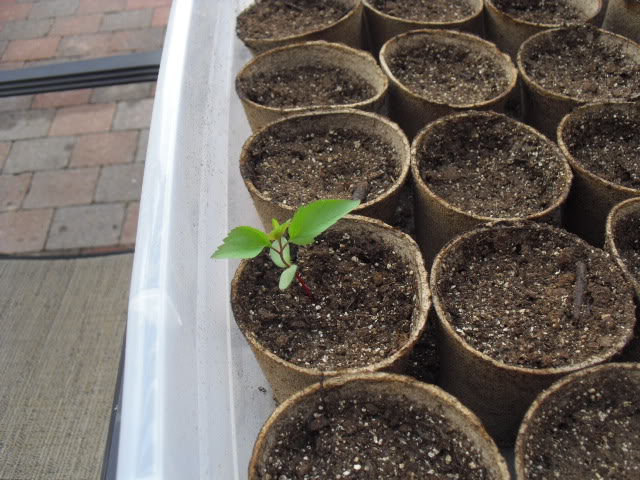
The second set allowed to set for a week in 50-60 degree temps has much better germination
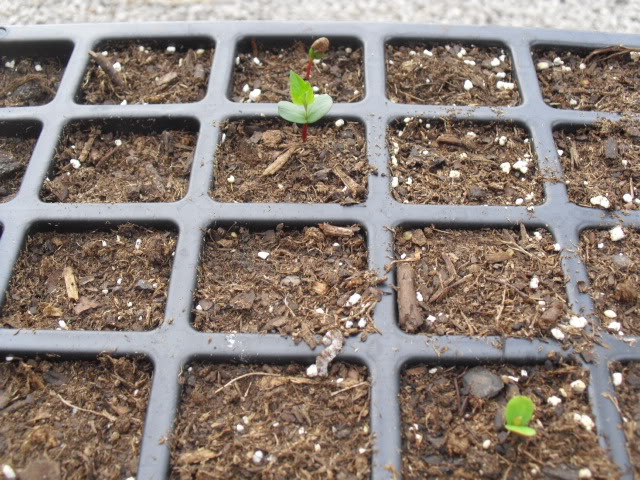
They have been in the 32 cell rootmaker for more then 10 days now and are just popping up
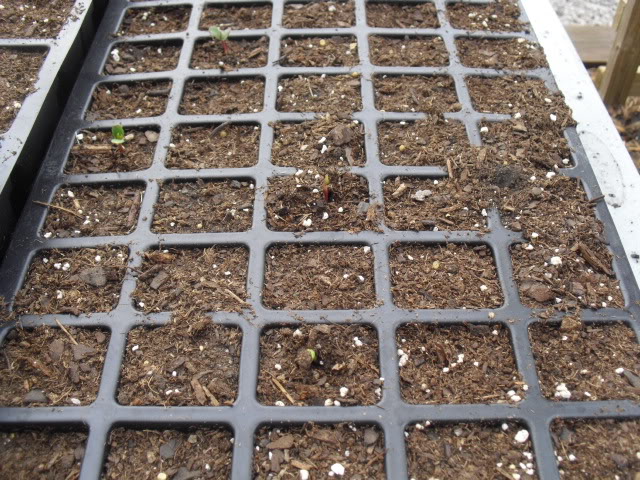
All of my Kazak apples have been outside 24-7 for nearly 2 weeks now and I only bring them in if temps drop below 40 (like tonight and Saturday is forecast too)
It's windy on our patio so I water no less then every other day and so far they seem to be thriving.
Whatever does germinate and grow will be transferred to Rootrapper bags later. :way:

The second set allowed to set for a week in 50-60 degree temps has much better germination

They have been in the 32 cell rootmaker for more then 10 days now and are just popping up

All of my Kazak apples have been outside 24-7 for nearly 2 weeks now and I only bring them in if temps drop below 40 (like tonight and Saturday is forecast too)
It's windy on our patio so I water no less then every other day and so far they seem to be thriving.
Whatever does germinate and grow will be transferred to Rootrapper bags later. :way:
JNRBRONC
Well-Known Member
Maybe a slight diversion, but it follows the theme of the thread: Apple trees.
Took a walk last night, saw that the apple trees I planted last year survived and one was flowering.

Then, on the way back up to the house, the deer browse line in the orchard really was obvious.



Took a walk last night, saw that the apple trees I planted last year survived and one was flowering.

Then, on the way back up to the house, the deer browse line in the orchard really was obvious.

dbltree
Super Moderator
deer browse line in the orchard really was obvious
Yikes Randy!
Some of mine are blooming also Phil! :way:
apple tree in clover plot?
Can someone tell me do apple tree roots grow near the top of the ground or do they go on the deep side? The reason i ask is, i`ve got a small clearing in the woods that i`d like to plant some clover and a patch/strip of brassica`s. I`ve got 5 apple trees(3 royal court and 2 honeycrisp) i`d like to plant down the middle. I`ve got a disc that i pull with a quad...will this hurt/kill the trees? I know the brassicas won`t grow well up near the trees(need sun) but hopefully some clover will...any thoughts?
Thank you.

Can someone tell me do apple tree roots grow near the top of the ground or do they go on the deep side? The reason i ask is, i`ve got a small clearing in the woods that i`d like to plant some clover and a patch/strip of brassica`s. I`ve got 5 apple trees(3 royal court and 2 honeycrisp) i`d like to plant down the middle. I`ve got a disc that i pull with a quad...will this hurt/kill the trees? I know the brassicas won`t grow well up near the trees(need sun) but hopefully some clover will...any thoughts?
Thank you.

dbltree
Super Moderator
I`ve got a disc that i pull with a quad...will this hurt/kill the trees?
I think you'll be fine with shallow cultivation around apple trees in your case. I have seen commercial orchards planted with rye in between in the fall with no apprant ill effects.
The roots of most trees really are pretty shallow traveling outward towards the drip line and you can do some damage with a plow for instance.
A small disc I think will be safe...
KSQ2
PMA Member
We planted 4 semi-dwarf apple trees from Adams County back in March (a couple goldrush and I can't remember the names of the other two). The trees seem to be growing well enough. One concern I have though is the leaves have some yellow spots on them. The new growth leaves do not, just the leaves that have been there a while. I did notice some bag worms on the two trees that are the most discolored, I went ahead and sprayed all four threes with some ortho fruit tree spray. I forgot to take the camera the other day when I was out there mowing or I'd post a pic.
dbltree
Super Moderator
One concern I have though is the leaves have some yellow spots on them.
Goldrush is, unfortunately very susceptable to Cedar Apple Rust and that is almost with out a doubt the spots you see on the leaves. My Goldrush trees get hit hard every year so as you plant more trees, look for those that resistant to CAR.
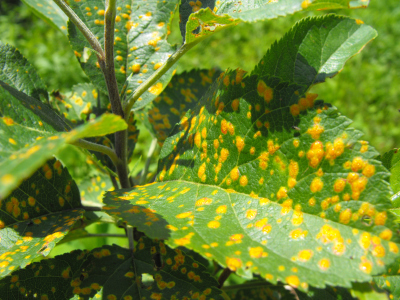
Here's some thoughts on controlling CAR
Cedars can be towering beauties in lawns and forests. The trees have a fresh, evergreen scent and are popular in home landscaping. Apple trees have an all-American appeal as both landscaping and fruit trees. But these two specimens can be brought down by minuscule organisms like the fungus gymnosporangium juniperi-virginianae, better known as cedar-apple rust. This fungus jumps back and forth between apple and cedar trees, and can affect the foliage and even growth of the trees. If you think your cedar or apple tree is affected, take some immediate steps to prevent the rust from spreading.
Diagnose cedar-apple rust to make sure you're treating the right condition. In mid to late summer, orange spots will appear on the leaves of an apple tree, and even leaves that aren't affected may appear discolored or thin. In mid spring, orange growths or galls will appear on the trunk and roots of a cedar tree. These grow after the spring flowering and release spores of cedar-apple rust to the apple trees nearby.
Spray the surrounding trees with fungicide in mid-April, when galls are beginning to form on cedar trees. Because cedar-apple rust spreads by jumping back and forth between apple and cedar trees, preventing the jump will interrupt the life cycle of the fungus. Spray apple trees thoroughly with fungicide, including both trunk and foliage. Consider spraying the galls on the cedar as well.
Repeat the process every seven to 10 days, until the galls are finished spreading their spores and begin to fade.
More links on CAR
Cedar-Apple Rust
Cedar-Apple Rust
This link has a great list of apple varieties and notes which ones are resistant(such as Liberty and Ark Black) and which ones are very highly susceptable such as Goldrush.
Cedar Apple Rust Information
Last edited:
Nontypcl1
Member
Dbltree is correct. It sounds like it is most likely cedar apple rust. Another common one that shows up late spring and early summer is frogeye leaf spot. Both can be orange to yellowish in color.
The best way to differentiate the two is that frogeye typically will have a dark purple or brown border around the outer edge of the lesion.
I also have some goldrush that I planted this year. Somehow I managed to keep ahead of the CAR even with 60 acres of cedars due west of me. However, I did end up with frogeye affecting them and some hundson's golden gem.
Pics of Cedar apple rust
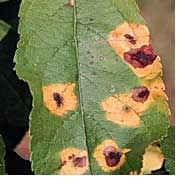
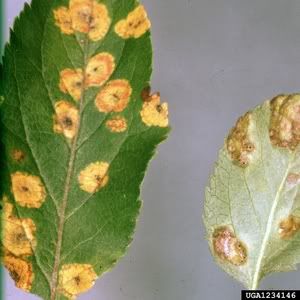
Frogeye leaf spot

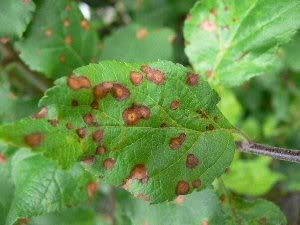
Spectrocide Immunox is probably on of the better choices for cedar apple rust and frogeye. However, it can be very hard to control either disease after infection. March thru early May are the best times to spray trees to prevent both diseases.
The best way to differentiate the two is that frogeye typically will have a dark purple or brown border around the outer edge of the lesion.
I also have some goldrush that I planted this year. Somehow I managed to keep ahead of the CAR even with 60 acres of cedars due west of me. However, I did end up with frogeye affecting them and some hundson's golden gem.
Pics of Cedar apple rust


Frogeye leaf spot


Spectrocide Immunox is probably on of the better choices for cedar apple rust and frogeye. However, it can be very hard to control either disease after infection. March thru early May are the best times to spray trees to prevent both diseases.
JNRBRONC
Well-Known Member
Some things I consider in regards to diseases:
Will it the disease kill the tree or just cut into production?
What am I spraying and how does it impact the environment?
How often will I need to spray?
What is the cost (dollar and environmental)?
I've got Cedar trees and the apple orchard almost touching. I've never sprayed the apple orchard for rust, only sprayed once or twice for insects until I decided against it.
So far, I get an apple crop every year that is adequate for personal consumption and deer feeding purposes.
Do you really need to invest the time, effort and money to maximize production and have "market perfect" apples and yields?
You need to make a personal choice.
Will it the disease kill the tree or just cut into production?
What am I spraying and how does it impact the environment?
How often will I need to spray?
What is the cost (dollar and environmental)?
I've got Cedar trees and the apple orchard almost touching. I've never sprayed the apple orchard for rust, only sprayed once or twice for insects until I decided against it.
So far, I get an apple crop every year that is adequate for personal consumption and deer feeding purposes.
Do you really need to invest the time, effort and money to maximize production and have "market perfect" apples and yields?
You need to make a personal choice.
KSQ2
PMA Member
So far, I get an apple crop every year that is adequate for personal consumption and deer feeding purposes.
Do you really need to invest the time, effort and money to maximize production and have "market perfect" apples and yields?
You need to make a personal choice. <!-- / message --><!-- sig -->
That's kind of what I was thinking, these trees are specifically for deer, we won't be consuming any of these apples. Did the disease affect the first couple of years growth on your trees?
In the future, I'll purchase more resistant trees, but with these I think I'll just let nature take its course.
Thanks for the replies fellas...
If you don't spray, keep an eye on them anyways... I broke my arm/back falling outta tree one year (putting up stands in late June), came back about 6 weeks later- was outta commission for a while- and caterpillers and other bugs ate every single leaf off many of my trees.
There's also some organic or natural sprays, etc that aren't so toxic (or toxic at all) that can be applied. On a different note- obviously make sure you protect trunk in fall from rabbits, mice and deer rubbing (rabbits will kill trees quickly if not protected).
There's also some organic or natural sprays, etc that aren't so toxic (or toxic at all) that can be applied. On a different note- obviously make sure you protect trunk in fall from rabbits, mice and deer rubbing (rabbits will kill trees quickly if not protected).
JNRBRONC
Well-Known Member
One thing I watch for with new trees are aphids. The leaves at the ends of the growing branches will be all wrinkled. If you look close, you might see hundreds of aphids stuck to the underside of the leaf. Another clue to aphid infestation is a trail of ants up and down the tree. The ants harvest "honey dew" from the aphids. Severe aphid infestations take away resources from the tree that it needs to put on new growth. There are lots of choices for dust/spray for aphids available at your local gardening shop.
Speaking of that, I need to take my bug dust with me next time I visit my new apple trees. :way:
Speaking of that, I need to take my bug dust with me next time I visit my new apple trees. :way:
Nontypcl1
Member
There's also some organic or natural sprays, etc that aren't so toxic
Some organic and natural insecticides and fungicides that I use at work on a regular basis include many neem oils for different fungal and insect problems. Lime-sulfur sprays for leaf spot, mildews, and blights. BT products such as Dipel for caterpillars and loopers. Spinosad (marketed by monteray) provides excellent control for caterpillars, thrips and will suppress aphid and mite populations. Copper based fungicides, such as Bordeaux, for bacterial and fungal diseases. Pyrethrum products will also control a number of insect pests including aphids.
Just a side note on the sulfur sprays. Do not use sulfur sprays within 2 weeks of applying an oil based spray or plant damage can result.
Also make sure to read the label on copper based fungicides as some plants can be sensitive to it. Although it is safe to use on apple trees.
Nontypcl1
Member
I'm guessing the product you're using is Ortho Home Orchard Spray or Bonide Fruit tree spray. I'm not aware of an ortho fruit tree spray. Either way, the combination products for fruit trees generally consist of the fungicide captan, and the insecticides malathion and carbaryl or methoxychlor.
It is safe to spray apple trees multiple times with these products. However you should abide by the recommended spray intervals printed on the label.
Also, a word of caution on captan. It should not be sprayed with oil sprays or soon after or before an oil spray is applied. 2 or 3 weeks in between would be fine.
Combination sprays are handy to use and can be very effective when used properly. With that in mind you should not use them during the bloom period because many times the insecticide included is very toxic to bees, which serve as your main pollinators. If you decide you want to spray for diseases during the bloom period, make sure you are using only a fungicide not a product containing insecticides. This will prevent any adverse effects to pollinating insects.
It is safe to spray apple trees multiple times with these products. However you should abide by the recommended spray intervals printed on the label.
Also, a word of caution on captan. It should not be sprayed with oil sprays or soon after or before an oil spray is applied. 2 or 3 weeks in between would be fine.
Combination sprays are handy to use and can be very effective when used properly. With that in mind you should not use them during the bloom period because many times the insecticide included is very toxic to bees, which serve as your main pollinators. If you decide you want to spray for diseases during the bloom period, make sure you are using only a fungicide not a product containing insecticides. This will prevent any adverse effects to pollinating insects.
KSQ2
PMA Member
It'll be time to order trees for next spring/late winter before you know it. With the trouble I've had with cedar apple rust, I was planning on ordering a couple Arkansas Blacks and a couple Nova Spy trees. That sound about right to you guys? Do any of you have any experience with the Nova Spy trees? I've been very happy with Adams County; I was planning on ordering from them again. I just wish they had something on their website specifically about cedar apple rust resistant trees. They have goldrush as one of their disease resistant trees, and they are very susceptable to cedar apple rust.


